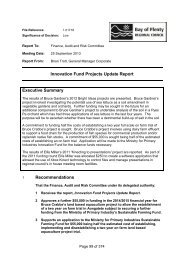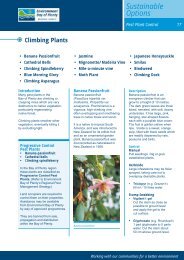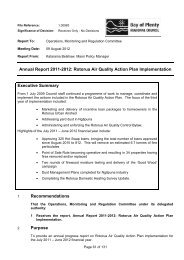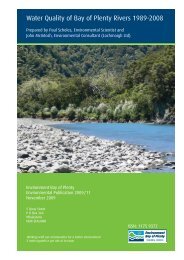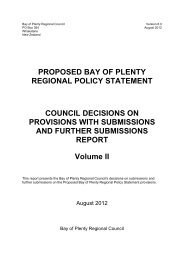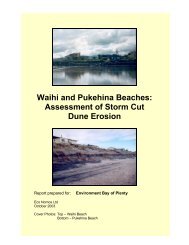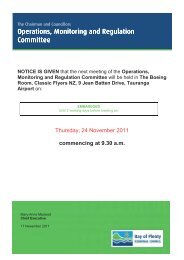Odour Threshold Investigation 2012 - Bay of Plenty Regional Council
Odour Threshold Investigation 2012 - Bay of Plenty Regional Council
Odour Threshold Investigation 2012 - Bay of Plenty Regional Council
You also want an ePaper? Increase the reach of your titles
YUMPU automatically turns print PDFs into web optimized ePapers that Google loves.
Part 3: H 2 S health effects<br />
The primary focus <strong>of</strong> this report in on the odour threshold for H 2 S but for completeness and<br />
context a brief summary <strong>of</strong> health effect information is given below. This has been extracted<br />
from the World Health Organisation Concise International Chemical Assessment Document<br />
53 14 .<br />
Because hydrogen sulphide is a gas, inhalation is the major route <strong>of</strong> exposure to hydrogen<br />
sulphide. Most human data are derived from acute poisoning case reports, occupational<br />
exposures, and limited community studies. In confined spaces, human acute poisonings<br />
continue to occur. Single inhalation exposures to high concentrations <strong>of</strong> hydrogen sulphide<br />
cause health effects in many systems. Health effects that have been observed in humans<br />
following exposure to hydrogen sulphide include death and respiratory, ocular, neurological,<br />
cardiovascular, metabolic, and reproductive effects.<br />
Respiratory, neurological, and ocular effects are the most sensitive end-points in humans<br />
following inhalation exposures. There are no adequate data on carcinogenicity.<br />
A summary <strong>of</strong> human health effects resulting from exposure to H 2 S is presented in Table 3.1.<br />
Table 3.1<br />
Human health effects at various hydrogen sulphide concentrations.<br />
Exposure<br />
(mg/m 3 )<br />
Effect/observation<br />
Reference<br />
0.011 <strong>Odour</strong> threshold. Amoore & Hautala, 1983<br />
2.8 Bronchial constriction in<br />
asthmatic individuals.<br />
Jappinen et al, 1990<br />
5.0 Increased eye complaints. Vanhoorne et al, 1995<br />
7 or 14 Increased blood lactate<br />
concentration, decreased<br />
skeletal muscle citrate<br />
synthase activity, decreased<br />
oxygen uptake.<br />
5-29 Eye irritation. IPCS, 1981<br />
28 Fatigue, loss <strong>of</strong> appetite,<br />
headache, irritability, poor<br />
memory, dizziness.<br />
Bhambhani & Singh, 1991;<br />
Bhambhani et al., 1996b,<br />
1997<br />
Ahlhorg, 1951<br />
>140 Olfactory paralysis. Hirsch & Zavala, 1999<br />
>560 Respiratory distress. Spolyar, 1951<br />
≥700 Death. Beauchamp et al, 1984<br />
14 WHO, 2003, Hydrogen Sulphide: Human Health Aspects. World Health Organisation, Geneva. Concise<br />
International Chemical Assessment Document (CICAD) No.53.<br />
Environmental Publication <strong>2012</strong>/06–A review <strong>of</strong> odour properties <strong>of</strong> H 2 S odour threshold investigation <strong>2012</strong> 9



